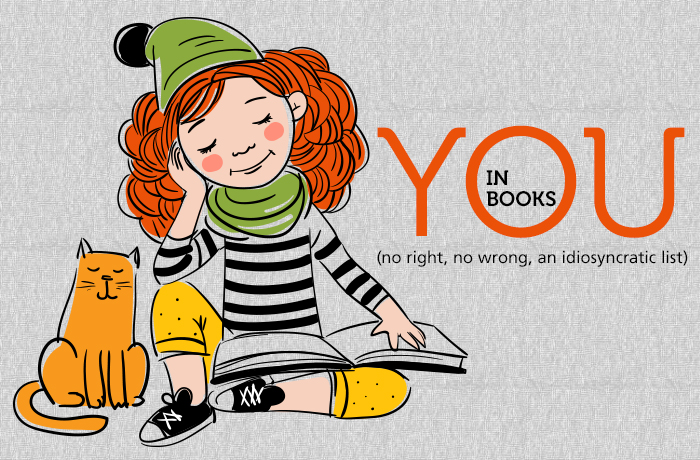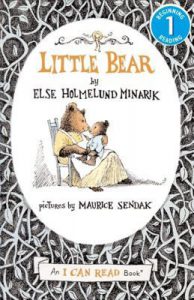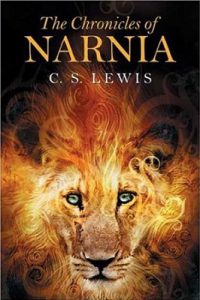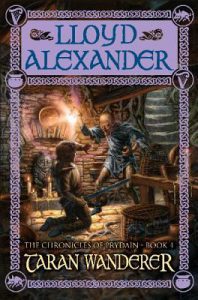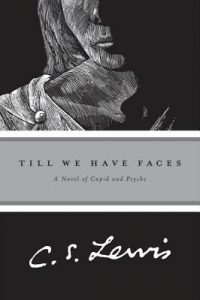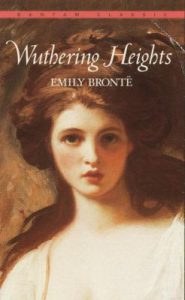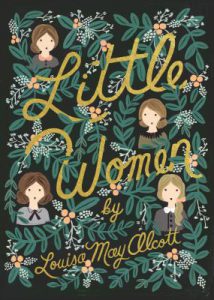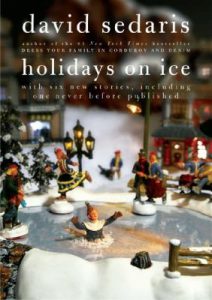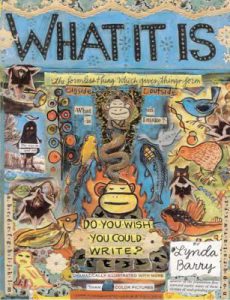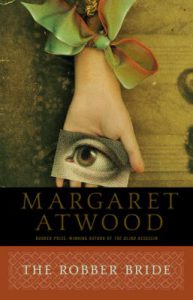You, in books (no right, no wrong, an idiosyncratic list)
Posted on May 2, 2017 at 6:00 am
by Sheri Boggs
If you’re a reader and you’re on any kind of social media, you’ve probably been tagged to participate in something like this:
“List 10 books that have stayed with you in some way. Don’t take more than a few minutes, and don’t think too hard. They do not have to be the ‘right’ books or great works of literature, just ones that have affected you in some way.”
I’ve seen similar memes for music and movies, but strangely enough, it’s the ones for books that tend to stress me out. I’m aware how silly that sounds—after all, I work in a library. But here’s why I think it stresses me out: it’s hard to give honest answers.
Even though the meme clearly says “they do not have to be the right books,” there’s a part of me that really wants to list the right books. Case in point: as soon as I jotted down my list, I was struck by its total lack of diversity and the fact that nearly everything on it is something I read as a child or in my early 20s. So I was tempted to replace some of the titles with ones that might make me look less white, less provincial, less childish, and less old. I’ve read Jhumpa Lahiri and Louise Erdrich, Zora Neale Hurston and Alice Walker, and liked them very much. I loved Lindy West’s memoir, Shrill, and just had my boss read Mallory Ortberg’s Texts from Jane Eyre. I’m not stuck in the past, or ruled by nostalgia, but the person I’ve become is very much shaped by things I read decades ago.
So with that in mind, here’s my very personal and idiosyncratic list, along with some thoughts about each title and what it’s meant to me over the years:
Little Bear, by Else Holmelund Minarik with illustrations by Maurice Sendak
I’ve been told I started reading the newspaper around the age of three. I think that’s hilarious. I’m sure this claim was wildly exaggerated, quite possibly fabricated Dad-pride, and also I have to wonder why I would have started reading with the Moscow-Pullman Daily News.
I don’t remember reading the newspaper, but what I do remember, quite vividly, is reading Little Bear. Minarik’s deceptively simple stories about a remarkably self-entertaining bear cub, making soup for his friends, flying to the moon, and having a birthday party, were strangely alluring in their own right, but it was really Maurice Sendak’s illustrations that stuck with me. His bears might have been standing on their hind legs or wearing aprons, but they still looked like real bears. The dark sketch work of his illustrations gave the books a sense of shadow and mystery that my weird child-self appreciated. I later learned that Little Bear was one of the first of a new breed of Beginning Readers for children, and was designed to inspire curiosity and engagement instead of passive repetition.
The Chronicles of Narnia, by C.S. Lewis
If there’s anything responsible for my enduring love of all things British—the dry wit, the appreciation for the absurd, the gentle stoicism—it’s this series. I read my first set until the pages started falling out and I had to put rubber bands around them.
I loved everything about Narnia: the way the characters spoke, the descriptions of everything from the marvelous tea at Mr. Tumnus’s house to the lilies and sweet water at the edge of the Eastern Sea, and especially Lewis’s way of speaking directly to the reader. For some kids, this authorial intrusiveness was a total deal breaker, but I. Ate. It. Up. . . ditto with the Christ analogy in The Lion, the Witch, and the Wardrobe. While some of my friends realized where this was all headed and chucked the book in disappointment, I started bugging my poor non-religious parents to take me to church. Years later, I still have Narnia in-jokes with friends who loved them as much as I did, and I still feel a little thrill when I see the image of a lion.
Taran Wanderer, by Lloyd Alexander
I loved all five of Lloyd Alexander’s books about the imaginary realm of Prydain, but when I was young, the fourth book, Taran Wanderer was my least favorite. There were no great battles, not as much humor, and not even a hint of romance as my favorite character (and the only girl) Eilonwy had been relegated off-page to learn how to be a princess.
Over the years however, Taran Wanderer, with its plotline of Taran going in search of his parentage to discover if he has enough royal blood to ask for the hand of Eilonwy, is the one that’s really stuck with me. Taran’s journey takes him to small villages, once-great castles, and humble homesteads. He learns pottery, weaving, and sword making. He meets kings and farmers, old friends and new enemies. An adult reader will immediately see that Taran finds himself—his real self—while trying to find out where he came from. Alexander’s humane, wise storytelling wraps a fantastic story around a primer for how to be a person in the world. Taran learns the lessons of patience, disappointment, thinking about others, and being grateful for what comes your way.
Till We Have Faces, by C.S. Lewis
My C.S. Lewis phase lasted into my early 20s and I read everything by him that I could get my hands on. Over time I started to drift away from Lewis, having become pretty darn agnostic and feminist. But I still love his ability to tell a story, and his retelling of the Cupid and Psyche myth, Till We Have Faces, is one I reread every five years or so.
The narrator is a bitter, aging woman cursing the gods for the losses she’s experienced in life, not least of which is her younger half-sister, Istra. As the narrator recounts everything that’s led her to this point in her life, Lewis paints a compelling picture of a singular, blazingly intelligent woman struggling against fate, and her own failings. The retelling of the myth is handled beautifully as well—Istra is Psyche in this story and even comes to be called by that name. Seeing the events of her sacrifice unfold through her older sister’s eyes gives the story a necessary distance. I think this is one of the first books I read where I didn’t feel anything like the main character was feeling, but I still couldn’t put it down. The older I get, the more I think Lewis did a fantastic job, not surprising since the narrator is rumored to be patterned after his opinionated wife, Joy.
Wuthering Heights, by Emily Bronte
When I first encountered Wuthering Heights, I was thirteen and like any other thirteen-year-old girl, I thought it was wildly romantic. It is not, however, a reliable primer for how to conduct yourself in relationships. In fact, the book is absolutely bonkers and I love it.
Reading it as an adult, all I can do is shiver at Emily Bronte’s genius and realize that, far from her depiction as the shyest Bronte, she actually had the wickedest sense of humor. She’s using the unreliable narrative device of a would-be dandy wandering into a house full of secrets and getting the skinny on the home’s inhabitants from the housekeeper. She includes two somewhat incestuous love triangles happening generations apart. Her characters share names, or are so phonetically similar, it’s sometimes hard to remember who is who. There are dark and stormy nights, dramatic deathbed scenes, ghosts at the window, and a dude clawing at his lady’s grave. This is everything a closet-Goth like me ever wanted. And as an adult fascinated by psychology and relationships, Wuthering Heights is not a romance so much as a really horrifying (yet satisfying) scab you can’t stop picking.
Little Women, by Louisa May Alcott
The first time I read this, I could NOT get over the scene where Theodore (Laurie) Laurence proposes to Jo and she refuses him. I remember rereading it in betrayed confusion, wondering if maybe I’d misunderstood. Laurie was handsome, mischievous, playful, educated, and, well, rich. What’s not to like? Even worse, she goes and marries and falls for a middle-aged German professor who keeps food in his pockets and criticizes her writing.
With time (and becoming middle-aged myself), I can appreciate someone as high strung as Jo needing a stable, kind person in her corner who knows she’s capable of so much more than writing potboilers. I also think a lot about the parts of the book related to maturing: how Jo shoots her mouth off about hating the French language and subsequently loses a trip to Paris on Aunt March’s dime. I’ve also thought often about Meg and her struggles with domesticity: trying to put up jam and worrying about being “on the shelf.” The contexts might be quaint to modern readers but the underlying emotions are not. Who hasn’t shot themselves in the foot by saying something rash, or worried about getting older and losing one’s charms?
Holidays on Ice, by David Sedaris
This collection of six holiday-themed short stories hit me at just the right time. I was working at Auntie’s Bookstore during the Christmas rush, I’d just dropped out of grad school and ended a relationship, and I was subsisting almost entirely on Starbucks’ Valencia orange mochas. To say that I was strung out was an understatement.
These stories—these dark, perverse, hilarious stories all about the shriveled and cynical heart of modern Christmas—were life giving. I read them all in one sitting, cry-laughing until the mascara was coursing down my face. Each piece is perfection. “The Santaland Diaries,” about Sedaris’s time working as a Macy’s Christmas elf, should be required reading for anyone working retail during the holidays. “Season’s Greetings to our Friends and Family” is full of all kinds of wrong. “Dinah the Christmas Whore” delivers one of my all-time favorite descriptions of a pair of shoes that “…in their bulk and color, resembled a matching set of paint cans.”
What It Is, by Lynda Barry
I’ve been a huge Lynda Barry fan since the late 80s and am sad to say that a lot of her early work is out of print. Fortunately, the graphic novel publisher Drawn & Quarterly has slowly been collecting and publishing some of her early strips (The Greatest of Marlys) alongside newer works like What It Is and Syllabus.
The Greatest of Marlys follows a group of kids growing up in the 60s and 70s in a neighborhood that may or may not be Ballard (where Barry herself grew up) but is full of adult awareness of how heartbreaking, wild, and dangerous one’s tween and teen years can really be. What It Is is one part art book and one part writing guide. Drawn from Barry’s experiences teaching, What It Is is constructed entirely of her pen-and-ink illustrations and collage on yellow legal pad paper and is super useful for stuck and/or insecure creatives in need of a little empathy. I’m really excited to see that Drawn & Quarterly is also republishing her “autobiofictionalography” One Hundred Demons in May and we’ve got it on order for the Library District’s collection.
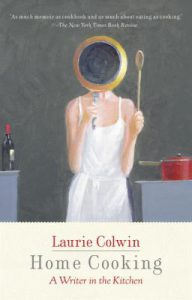
Home Cooking: a Writer in the Kitchen, by Laurie Colwin
Laurie Colwin is another writer I discovered in the late 80s, and whose writing I still think about even though her last novel was published in 1993 (a year after she died of an untimely heart attack). Reading her is like watching your favorite Nora Ephron movie. Everything is set in New York. Her characters go to the theater and say witty things on the walk home. The interior details are lovingly observed and described, but they never overshadow the human relationships at the center of the story.
This is even true of her food writing, which reads almost like her fiction with herself as a witty and astute narrator/host. In Home Cooking: a Writer in the Kitchen she shares how she learned to cook eggplant, what it was like to host dinner parties in a tiny studio apartment with only a hot plate and a bathtub for a sink, and her unpretentious recipes for everything from potato salad to fried chicken. The best piece in the whole book—the one that made me a fan for life and which I still tell food-loving friends to read—is “Repulsive Dinners,” her hilarious run-down of regrettable meals hosted by other people. It still, no matter how many times I’ve read it, makes me laugh.
The Robber Bride, by Margaret Atwood
Margaret Atwood has written a lot of important, literary books. The Robber Bride is not one of them; however, it’s my favorite and has stayed with me as a sort of cautionary tale. Set in Toronto in the present-ish day, it opens with three old friends meeting for lunch: precise, academic Tony, ebullient, larger-than-life Roz, and gentle, New Age-y Charis. There is nothing that these three women should have in common and yet they do: each was systematically befriended, duped, and betrayed by a sexy sociopath named Zenia. Less about major social issues or futuristic dystopias than Atwood’s other works, The Robber Bride is compulsively readable. Her characters are somewhat types, but that doesn’t mean that Atwood is a sloppy writer, and in fact, her emotional distance from her characters allows her to show how Zenia is able to identify and take advantage of their weaknesses. I haven’t read it in many years, but I still think about the themes of female friendship, rivalry, and how well you can ever really know or trust someone.
So, readers, what would your list of “books that shaped or stayed with you” look like?

